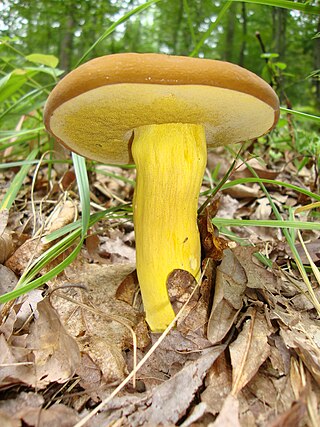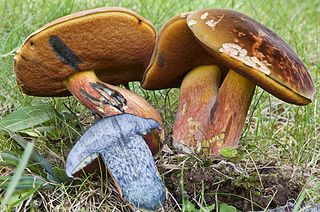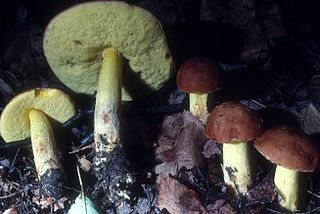
Baorangia bicolor, also known as the two-colored bolete or red and yellow bolete after its two-tone coloring scheme of red and yellow, is an edible fungus in the genus Baorangia. It inhabits most of eastern North America, primarily east of the Rocky Mountains and in season during the summer and fall months but can be found across the globe in China and Nepal. Its fruit body, the mushroom, is classed as medium or large in size, which helps distinguish it from the many similar appearing species that have a smaller stature. A deep blue/indigo bruising of the pore surface and a less dramatic bruising coloration change in the stem over a period of several minutes are identifying characteristics that distinguish it from the similar poisonous species Boletus sensibilis. There are two variations of this species, variety borealis and variety subreticulatus, and several other similar species of fungi are not poisonous.

Butyriboletus appendiculatus is an edible pored mushroom that grows under oaks and other broad leaved trees such as beech. It is commonly known as the butter bolete. It often grows in large colonies beneath the oak trees, and is frequently found cohabiting with old oaks in ancient woodland. It is relatively rare in Britain. Its stipe and pores are often bright yellow and its flesh stains bright blue when cut or bruised.

Boletus sensibilis is a species of fungus in the family Boletaceae. The species was first described scientifically by American mycologist Charles Horton Peck in 1879. This species is very similar to two other red boletes, Baorangia bicolor and Boletus pseudosensibilis.

Boletellus ananas, commonly known as the pineapple bolete, is a mushroom in the family Boletaceae, and the type species of the genus Boletellus. It is distributed in southeastern North America, northeastern South America, Asia, and New Zealand, where it grows scattered or in groups on the ground, often at the base of oak and pine trees. The fruit body is characterized by the reddish-pink scales on the cap that are often found hanging from the edge. The pore surface on the underside of the cap is made of irregular or angular pores up to 2 mm wide that bruise a blue color. It is yellow when young but ages to a deep olive-brown color. Microscopically, B. ananas is distinguished by large spores with cross striae on the ridges and spirally encrusted hyphae in the marginal appendiculae and flesh of the stem. Previously known as Boletus ananas and Boletus coccinea, the species was given its current name by William Alphonso Murrill in 1909. Two varieties of Boletellus ananas have been described. Although the mushroom may be considered edible, it is not recommended for consumption.

Tylopilus alboater, called the black velvet bolete, by some, is a bolete fungus in the family Boletaceae. The species is found in North America east of the Rocky Mountains, and in eastern Asia, including China, Japan, Taiwan, and Thailand. A mycorrhizal species, it grows solitarily, scattered, or in groups on the ground usually under deciduous trees, particularly oak, although it has been recorded from deciduous, coniferous, and mixed forests.

Boletus gertrudiae is a species of bolete fungus in the family Boletaceae. Found in North America, it was first described scientifically by mycologist Charles Horton Peck in 1911, from collections made in Old Lyme, Connecticut. The specific epithet honors Miss Gertrude Wells who "though young in years, has already manifested a remarkable interest in mushrooms and has a wonderful proficiency in the knowledge of them."

Boletus curtisii is a species of fungus in the family Boletaceae. It produces small- to medium-sized fruit bodies (mushrooms) with a convex cap up to 9.5 cm (3.7 in) wide atop a slender stem that can reach a length of 12 cm (4.7 in). In young specimens, the cap and stem are bright golden yellow, although the color dulls to brownish when old. Both the stem and cap are slimy or sticky when young. On the underside of the cap are small circular to angular pores. The mushroom is edible, but not appealing. It is found in eastern and southern North America, where it grows in a mycorrhizal association with hardwood and conifer trees. Once classified as a species of Pulveroboletus, the yellow color of B. curtisii is a result of pigments chemically distinct from those responsible for the yellow coloring of Pulveroboletus.

Boletus auripes, commonly known as the butter-foot bolete, is a species of bolete fungus in the family Boletaceae. First described from New York in 1898, the fungus is found in eastern Asia, Central America, and eastern North America from Canada to Florida. It is a mycorrhizal species and typically grows in association with oak and beech trees.

Xerocomus illudens is a species of bolete fungus in the family Boletaceae. Described as new to science in 1898, it is found in Asia and North America, where it grows in a mycorrhizal association with oak.

Boletus subvelutipes, commonly known as the red-mouth bolete, is a bolete fungus in the family Boletaceae. It is found in Asia and North America, where it fruits on the ground in a mycorrhizal association with both deciduous and coniferous trees. Its fruit bodies (mushrooms) have a brown to reddish-brown cap, bright yellow cap flesh, and a stem covered by furfuraceous to punctate ornamentation and dark red hairs at the base. Its flesh instantly stains blue when cut, but slowly fades to white. The fruit bodies are poisonous, and produce symptoms of gastrointestinal distress if consumed.

Boletus vermiculosus is a species of bolete fungus in the family Boletaceae. Found in North America, it was described as new to science in 1872 by mycologist Charles Horton Peck.

Boletus variipes is a species of mycorrhizal bolete fungus in the family Boletaceae, native to North America. It was originally described by American mycologist Charles Horton Peck in 1888.

Retiboletus ornatipes, commonly known as the ornate-stalked bolete or goldstalk, is a species of bolete fungus in the family Boletaceae. Originally named Boletus ornatipes by American mycologist Charles Horton Peck in 1878, it was transferred to Retiboletus in 2002.

Hemileccinum subglabripes is a fungus of the family Boletaceae native to North America. It was first described by Charles Horton Peck in 1887 as Boletus subglabripes. In 2015 it was transferred to Hemileccinum based on DNA evidence.

Austroboletus gracilis is a species of bolete fungus in the family Boletaceae. Originally described as Boletus gracilis by Charles Horton Peck in 1872, it was transferred to the genus Austroboletus by Carl B. Wolfe in 1979.
Tylopilus nebulosus is a species of bolete fungus in the family Boletaceae found in eastern North America. It was originally described by Charles Horton Peck in 1898 as a species of Boletus, from collections made in Ray Brook, New York. Carl B. Wolfe transferred it to the genus Tylopilus in 1980.

Suillus punctipes, commonly known as the spicy suillus, is a bolete fungus in the family Suillaceae.

Aureoboletus auriporus, is a species of bolete fungus in the family Boletaceae that is found in Europe and North America. It was originally described in 1872 by American mycologist Charles Horton Peck, who called it Boletus auriporus. Zdenek Pouzar transferred it to the genus Aureoboletus in 1957.
















